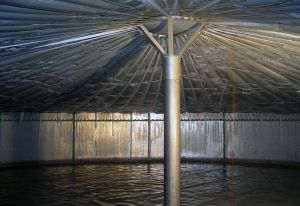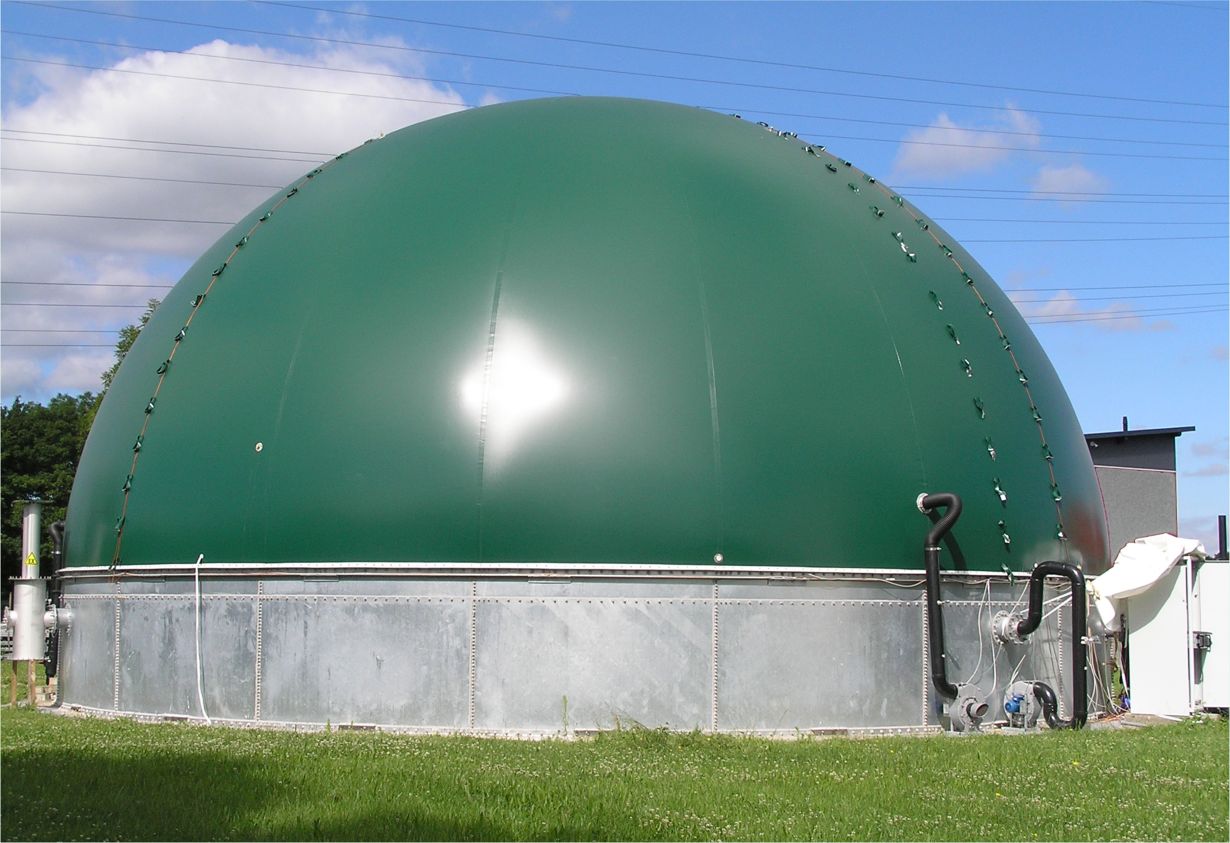Biogas plants produce methane from agricultural residues. This energy carrier is then mostly stored in membrane gas holders. In Germany, however, these storage systems are often outdated. Via leaks, methane is released into the atmosphere, where it damages the climate. With an improved design, effective standards, and optimized operation concepts, however, these systems might be highly useful for the energy transition, scientists of Karlsruhe Institute of Technology (KIT) think. Within a research project funded by the Ministry of Food and Agriculture (BMEL), they studied fabric gas holders.
They can be seen mainly in the rural regions of Germany – dome-shaped or flat membrane storage systems. Sometimes, dozens of them are located near farms. Gaseous products from biogas plants, above all methane, are stored underneath a fabric shell filled with air. “As biogas is produced by the digestion of organic substances, it is CO2-neutral and may contribute decisively to the energy transition,” says Professor Rosemarie Wagner from KIT’s Institute of Building Design and Technology (IEB). “Methane can be stored and converted into power, if necessary, to compensate fluctuations of wind and solar power, for instance. In reprocessed form, it can also be fed directly into the natural gas grid.” Still, membrane storage systems are criticized by many climate protectors, and justifiably so. “Presently, these storage systems in Germany are in a bad condition. Due to acute technical deficiencies, up to 80% of all fabric gas holders will have to be exchanged in the next years. About 5% of the methane produced are released into the atmosphere uncontrolled.”
Wagner’s team experimentally studied fabric biogas holders within a research project of two years’ duration funded by the Federal Ministry of Food and Agriculture (BMEL). The project was carried out in cooperation with technet, Seybold, and Wacker Bauwerksaerodynamik.

Membrane Gas Holders Sensitively Respond to Environmental Impacts
So far, data and methods to calculate a permanently gas-tight design and to control and construct the membrane storage systems have been lacking. “Scientific studies of the interaction between environmental conditions, air, and gas masses and between mass and volume flows of membrane storage systems simply do not exist,” says Kai Heinlein (IEB), who was centrally involved in research. For the project, the researchers therefore built an accessible test plant for data collection without biogas. This test plant was equipped with two pressure-stabilized fabric layers. Air blowers were used to simulate various filing levels. Pressure sensors and cameras were applied to observe the behavior of the holder over the seasons under varying weather conditions.
The fabric biogas holder was found to respond very sensitively to environmental impacts, such as wind, heat or cold. This response varied as a function of the filling level. Under unfavorable operation conditions, this may cause problems: “When a gas holder is filled to bursting, a hot summer day may be sufficient to cause failure of the seams, because gases expand rapidly,” Heinlein says. “If, however, cold wind meets with a low filling level, the membrane may be damaged by fluttering and thrashing.” These effects become significant as a result of the large gas volumes stored in the membrane holders. In Germany, the volumes may amount up to 10,000 cubic meters.
Hemispherical Design Triples the Storage Volume
Meanwhile, the team of IEB has handed over the final report with the results of the experiments to the Federal Ministry of Agriculture. The measured results will be used in follow-up projects for the development of data-based models of the interaction of parameters and states. “Such models are urgently required to ensure sustainable long-term operation of the gas holders,” Wagner says. Apart from data, the report also provides evidence of deficiencies of commercial storage systems. For example, the technology traditionally used to determine the filling level as a central parameter produces inaccurate results. Control of the air pressure in the outer shell lacks flexibility in reacting to external conditions. In most cases, the membrane roof is pumped up at regular intervals. Here, a pressurized air control might be used instead.
A central finding of the researchers refers to the design of future storage systems. Studies of the hemispherical design revealed that this geometrically favorable design is also suited for biogas holders. Compared to the present spherical design, storage volume is tripled.
https://www.fnr-server.de/ftp/pdf/berichte/22403315.pdf (in German)
More about the KIT Energy Center: http://www.energy.kit.edu
In close partnership with society, KIT develops solutions for urgent challenges – from climate change, energy transition and sustainable use of natural resources to artificial intelligence, sovereignty and an aging population. As The University in the Helmholtz Association, KIT unites scientific excellence from insight to application-driven research under one roof – and is thus in a unique position to drive this transformation. As a University of Excellence, KIT offers its more than 10,000 employees and 22,800 students outstanding opportunities to shape a sustainable and resilient future. KIT – Science for Impact.

